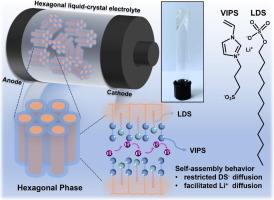Hexagonal liquid crystals as emerging quasi solid-state electrolytes for aqueous lithium-ion batteries
IF 13.3
1区 工程技术
Q1 ENGINEERING, CHEMICAL
引用次数: 0
Abstract
The increasing market demand ranging from portable electronics to electric vehicles drives the advancement of lithium-ion batteries. However, traditional liquid electrolytes used in LIBs are plagued by issues such as leakage, vaporization, and the degradation of active materials, which compromise performance and pose safety risks. To address these challenges, herein, the liquid-crystalline electrolytes with hexagonal phase were designed based on the self-assembly of amphiphilic molecules, which exhibit both high ionic conductivity and a high Li+ transference number. The hexagonal liquid crystal structure reconfigures the Li+ solvation structure and provides a transport pathway for the Li+ structural diffusion, facilitating the efficient transport of Li+ and contributing to the high ionic conductivity. Furthermore, the ordered arrangement of amphiphilic anion significantly restricts anion diffusion, resulting in an exceptionally high Li+ transference number of 0.92. Additionally, when utilizing NaV3O8 (NVO) as the anode and LiMn2O4 (LMO) as the cathode, the resultant full cell delivers impressive rate performance and stable cycling performance. This work highlights the potential of lyotropic liquid crystals in the development of high-performance quasi solid-state electrolytes for aqueous lithium-ion batteries and beyond

六方液晶作为水性锂离子电池的新兴准固态电解质
从便携式电子产品到电动汽车,日益增长的市场需求推动了锂离子电池的发展。然而,锂离子电池中使用的传统液态电解质存在泄漏、汽化和活性材料降解等问题,从而影响了电池的性能并带来安全风险。为了应对这些挑战,本文基于两亲性分子的自组装,设计了具有六方相的液晶电解质,这种电解质同时具有高离子电导率和高锂离子转移率。六方液晶结构重新配置了 Li+ 溶解结构,为 Li+ 结构扩散提供了传输途径,促进了 Li+ 的高效传输,从而实现了高离子电导率。此外,两亲阴离子的有序排列极大地限制了阴离子的扩散,从而使 Li+ 的传输数达到了 0.92 的超高水平。此外,当使用 NaV3O8(NVO)作为阳极和 LiMn2O4(LMO)作为阴极时,所产生的全电池具有令人印象深刻的速率性能和稳定的循环性能。这项工作凸显了各向同性液晶在开发用于水性锂离子电池及其他应用的高性能准固态电解质方面的潜力。
本文章由计算机程序翻译,如有差异,请以英文原文为准。
求助全文
约1分钟内获得全文
求助全文
来源期刊

Chemical Engineering Journal
工程技术-工程:化工
CiteScore
21.70
自引率
9.30%
发文量
6781
审稿时长
2.4 months
期刊介绍:
The Chemical Engineering Journal is an international research journal that invites contributions of original and novel fundamental research. It aims to provide an international platform for presenting original fundamental research, interpretative reviews, and discussions on new developments in chemical engineering. The journal welcomes papers that describe novel theory and its practical application, as well as those that demonstrate the transfer of techniques from other disciplines. It also welcomes reports on carefully conducted experimental work that is soundly interpreted. The main focus of the journal is on original and rigorous research results that have broad significance. The Catalysis section within the Chemical Engineering Journal focuses specifically on Experimental and Theoretical studies in the fields of heterogeneous catalysis, molecular catalysis, and biocatalysis. These studies have industrial impact on various sectors such as chemicals, energy, materials, foods, healthcare, and environmental protection.
 求助内容:
求助内容: 应助结果提醒方式:
应助结果提醒方式:


